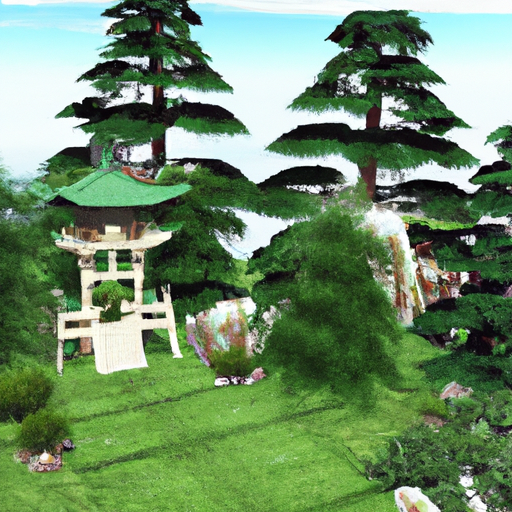Stepping into the enchanting realm of Asian garden designs, you’re about to uncover the fascinating interwoven story of how various Asian garden styles have greatly influenced iconic Japanese designs. “Cultural Crossovers: Influence of Other Asian Gardens on Japanese Designs” takes you on a vibrant journey through the intricate elements of Chinese, Korean, and Thai landscapes that have left their indelible mark on Japanese garden architecture. This stimulating narrative promises to captivate your senses by exploring, highlighting, and appreciating the ethereal, tranquil beauty of Japanese gardens and the Asian inspirations behind them.
The Evolution of Japanese Gardens
Japanese gardens enchant with their tranquil beauty, representing a unique fusion of nature, spirituality, and artistry. Have you ever wondered how these peaceful paradises evolved? The development of Japanese shrine and garden aesthetics is a tale steeped in cultural crossovers and symbiotic relationships with other Asian cultures.
Concept of Ancient Japanese Gardens
Japanese gardens didn’t spring into existence overnight. Like a seed transforming into a blossoming tree, their evolution commenced with the primitive elements rooted in the indigenous Japanese landscape. Ancient Japanese gardens were primarily more than just aesthetic pieces; they were spaces of practicality and functionality, used for purposes such as growing lotus plants and fishing.
Significance of Natural Landscapes in Japanese Garden Designs
The cornerstone of Japanese garden design lies in its respect towards and replication of natural landscapes. The Japanese garden artisans see nature as the ultimate master of beauty; therefore, their designs aim to create miniature versions of natural sceneries like mountains, valleys, streams, and woodlands. They see in nature not just an opportunity for aesthetic pleasure, but also a space for meditation and contemplation.
Chinese Influence on Japanese Gardens
Chinese horticultural and aesthetic philosophies played a significant role in shaping the Japanese garden design. While maintaining a unique style of its own, the Japanese garden borrows heavily from the Chinese.
Impact of Chinese Gardening Philosophy
The Chinese gardening philosophy stems from Taoism and Confucianism, which respect nature’s rhythms and strive to create harmony between humans and the natural world. These philosophies found their way into the Japanese gardens too, leading to designs that emphasized harmony, tranquility, and respect for timeless values.
Borrowed Elements from Chinese Zen Gardens
Elements like stone lanterns, water basins, stepping-stone paths, and Zen rock gardens significantly originated in China before being incorporated into Japanese designs. These borrowed elements go beyond beautification; they have spiritual and philosophical connotations tethered to Buddhist teaching, further enriching the layers of symbolism in a Japanese garden.
Korean Impact on Japanese Garden Design
The Korean influence on Japanese gardens is subtler but nonetheless impactful. Korean horticultural techniques and aesthetics have been an integral part of Japanese garden evolution.
Adoption of Korean Horticultural Techniques
Traditional Korean gardens emphasize harmony and unity. This philosophy is echoed in their techniques that focus on grouping plant species based on their shared needs concerning water, soil, and sun. Japanese gardens borrowed these horticultural practices, promoting a healthier and more sustainable garden ecosystem.
Influence of Korean Aesthetics and Symbols
In addition to horticultural techniques, the Korean influence extends to the aesthetic domain. Elements like traditional Korean pavilions, turtle-shaped islands (representing longevity), and bridges (symbolizing passage to paradise) find representation in Japanese gardens.
Indian Influence on Japanese Gardens
The Indian culture has significantly influenced Japanese gardens, primarily through the introduction of Buddhist elements and horticultural practices.
Introduction to Buddhist Cultural Elements
Buddhism originated in India and morphed into a cultural bridge between India and Japan. Japanese gardens personify the Buddhist teachings about the impermanence of the world and the necessity for inner peace amidst change.
Inclusion of Indian Horticultural Practices
Indian horticultural practices, with their emphasis on functional gardening, have given Japanese garden designs a more utilitarian approach alongside their aesthetic appeal.
Influence of Southeast Asian Garden Aesthetics
Southeast Asian countries like Thailand and Indonesia (especially Bali) have influenced the Japanese gardens through their unique garden aesthetics.
Effect of Balinese and Thai Elements
Balinese and Thai gardens are known for their splendid water features, wooden structures, and amber hues. They brought a tropical aesthetic into the Japanese traditional design, fusing exotic beauty with indigenous elements.
Incorporation of Tropical Flora from Southeast Asia
Japan’s native plant palette was expanded through the incorporation of tropical flora from Southeast Asia. This allowed for a broader use of color, texture, and complexity in the garden designs.
Modern Japanese Garden Techniques
A reflection of the past and a nod towards the future, the modern Japanese garden retains the fondness for tradition while embracing contemporary trends.
Development of Hybrid Designs
By adopting foreign elements and horticultural practices, Japanese gardens have evolved into hybrid designs that blend tradition and innovation. They capture the quintessence of different cultures, creating a seamless fusion of diverse gardening techniques.
Intersection of Tradition and Innovation in Japanese Gardens
Modern Japanese gardens beautifully demonstrate the intersection of tradition and innovation. While preserving age-old design principles like asymmetry and naturalism, they incorporate innovative elements and technologies to meet modern requirements.
Japanese Gardens as a Reflection of Cultural Exchange
As apparent from the multicultural influence, Japanese garden evolution is a testament to cultural exchange. It reflects how cultures interact, influence, and modify each other across time.
Multicultural Influences as an Asset
Far from diluting the authenticity of Japanese gardens, the multicultural influences have reiterated the unique Japanese ability to adapt and synthesize foreign elements into indigenous designs. It highlights Japan’s openness to embrace different cultures and ideas, using them as a rich resource to enhance its uniqueness.
Symbolism and Cultural Significance of Borrowed Elements
Incorporating foreign elements is not merely about aestheticism; it also carries cultural and symbolic significance. Each borrowed element comes with a story and symbolic meaning, enriching the symbolism in Japanese garden designs.
Challenges in Conserving the Authenticity of Japanese Gardens
The incorporation of diverse influences poses challenges in preserving the authenticity of Japanese gardens.
Maintaining Traditional Japanese Aesthetics
Amid the fusion of various elements, the integrity of traditional Japanese aesthetics must be maintained. Future designers must prioritize preserving Japan’s traditional aesthetics without becoming stagnant or outdated.
Balancing Originality and Multicultural Influences
Striking a balance between originality and multicultural influence is another crucial challenge. While it is beneficial to incorporate foreign elements into designs, it’s essential to ensure that the designs don’t lose their initial essence.
The Future of Japanese Gardens
The future of traditional Japanese gardens looks both promising and intriguing, poised at the intersection of tradition and innovation.
Emergence of Pan-Asian Gardening Trends
With the emergence of Pan-Asian gardening trends, it’s expected that Japanese gardens will continue to evolve, enriched with elements from various Asian cultures, reflecting a sense of unity within diversity.
Role of Japanese Gardens in Promoting Cultural Diplomacy
Japanese gardens play an integral role in promoting cultural diplomacy, establishing bridges of understanding and mutual respect between Japan and the world. By embodying diverse influences, they foster intercultural dialogue and serve as a platform for cultural exchange.
Case Study: Comparative Analysis of Different Asian Gardens and Their Influence on Japanese Designs
The rich tapestry of Japanese garden aesthetics is woven from threads of various Asian garden aesthetics.
Assessing Similarities and Differences
Comparative analysis of different Asian gardens showcases the tangible similarities and differences within their designs. It also sheds light on how Japanese gardens have gained influence from these diverse sources, illustrating the dynamic interaction of different cultures.
Influence of Regional Climates and Native Flora on Design
The influence of regional climates and native flora on garden design cannot be overlooked. Japanese gardens, while retaining their unique identity, have adapted to incorporate various regional flora, contributing to a richer biodiversity and dynamic aesthetic. Through their evolution, Japanese gardens tell a multilayered story of cultural exchange, adaptation, and transformation, offering a serene journey through time. The story of Japanese gardens is not yet complete; it continues to evolve, storing more mystery, beauty, and symbolism within its folds.








